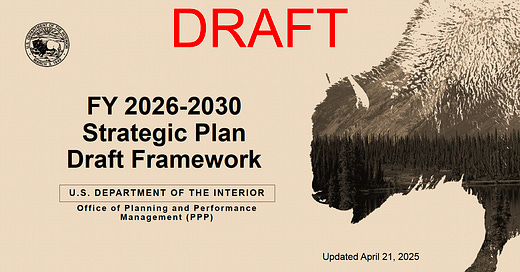SCOOP: Draft Strategic Plan for Trump's Interior Department Would Boost Extractive Industries, Cut Protections
The internal document calls for opening new lands to oil and gas drilling, coal mining and other uses. It does not mention climate change once.
The nation’s largest land management agency is gearing up to squeeze revenue from the federal estate, opening up new lands to drilling and other extractive development while reducing federal land holdings and slashing environmental regulations, with its top goal being to “restore American prosperity,” according to a draft strategic plan that Public Domain obtained.
The internal Interior Department document, dated April 21, lists four strategic goals for President Donald Trump’s second term: 1) Restore American Prosperity, 2) Ensure National Security Through Infrastructure and Innovation, 3) Enjoy Our Natural Resources While Ensuring They Remain Sound And Sustainable, and 4) Collaboration and Coordination Results in Better Outcomes for the Nation, States, and the People.
The document, written as a string of bullet points, remains broad and vague. But taken as a whole, much of it reads like an industry wish list, with pride of place given to boosting oil, gas and coal production and opening lands to development. Nowhere does the document mention climate change.
The draft strategy leans heavily on language that Interior Secretary Doug Burgum has repeatedly used to describe America’s public lands and natural resources — as “assets” on a “balance sheet” that the Americans deserve a better return on.
“The nation treats natural resources as national assets,” reads a bullet point in the Goal 1 section.
The document calls specifically to “open Alaska and other Federal lands for mineral extraction,” while mapping out all Interior-held lands for energy and minerals and quantifying their value. It envisions a reduction in federal public land holdings, calling for the “release” of federal lands to state and local communities for housing development and returning “heritage lands and sites to the states.” Additionally, the department lists “assess and right-size monuments” as a key strategy — all but confirming its intent to dismantle the boundaries of already protected national monuments — and generally putting federal lands “to use.”
“It is beyond unacceptable that an internal document in the draft/deliberative process is being shared with the media before a decision point has been made,” an Interior Department spokesperson wrote in response to queries from Public Domain. “Not only is this unacceptable behavior, it is irresponsible for a media outlet to publish a draft document. We will take this leak of an internal, pre-decisional document very seriously and find out who is responsible. The internal document is marked draft/deliberative for a reason - it’s not final nor ready for release.”
You can read the draft strategic plan here:
While the Interior draft plan sets a goal to “increase revenues” from grazing, timber, mining and other development on federal lands, it simultaneously aims to “reduce the costs for grazing and other land uses.” DOI generates revenue from grazing and resource extraction from private parties through leasing and royalties. Increasing revenue while reducing costs for those private interests would likely require increasing the scale of such uses.
The draft also calls for delisting some species from Endangered Species Act protections and “streamlining” the National Environmental Policy Act, indicators that both bedrock environmental laws will be weakened or watered down in the years ahead. The document proposes tracking delistings as a key metric of success.
The extraction-first plan does in places promote conservation. It says the Department will ensure “ecosystems are healthy, balanced and thrive,” though conservation groups broadly agree that industrial exploitation undermines ecological health. It also calls for cleaning up abandoned coal mines, ensuring aquifers are clean, promoting hunting and fishing and maintaining trails for public access. “Manage land, water and public sites through protection and conservation,” it says down on page 14.
The document also stresses the importance of ensuring sovereignty and self-determination for tribal nations, while promoting co-management of federal resources and supporting “Native community traditional use” of lands. The Interior Department is responsible for overseeing the government’s trust responsibilities to federally recognized tribes, through its Bureau of Indian Affairs.
The draft also indicates that the Department will pursue further cuts at agencies already reeling from mass firings, resignations and retirements inspired by Elon Musk’s DOGE. Among other things the document mentions the reduction of “unnecessary” staff, canceled facility leases, a “reduction in unnecessary vehicles (electric vehicles)” and “removal of unnecessary assets”. “Facility/asset divestment” is also highlighted in the document.
DOI will seek input from the public, tribes and Congress from May to July and plans to finalize its strategy by October, according to the draft.







